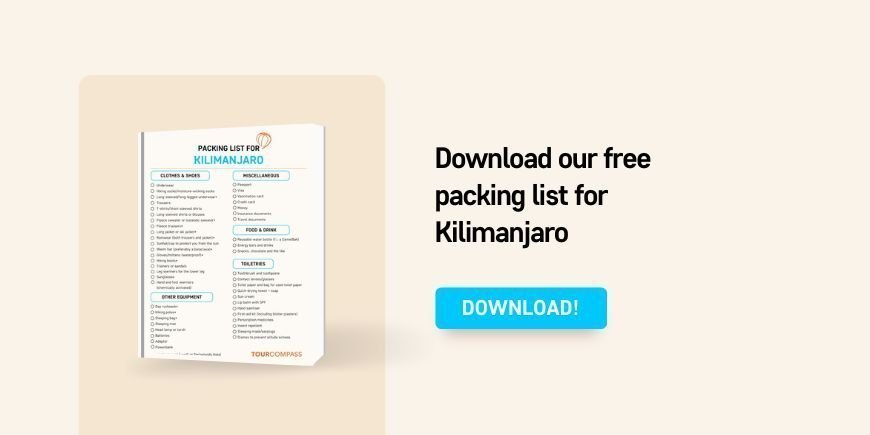Packing list for Kilimanjaro – including free PDF checklist
11/02/2024 | updated: 15/08/2024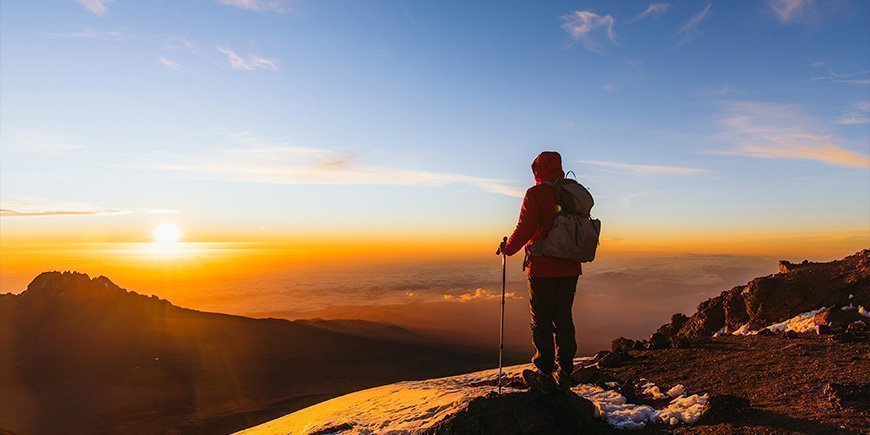
A tour to Kilimanjaro is so much more than just a hike.
It’s an expedition to the top of Africa and a personal challenge of the highest calibre.
To ensure your tour is a success, it’s essential to be prepared and pack smart.
We’ve answered all the questions our guests frequently ask about what is important to pack, and compiled a packing list where we’ve put together all the things you’re likely to need when climbing Kilimanjaro.
FAQs about what to pack for Kilimanjaro
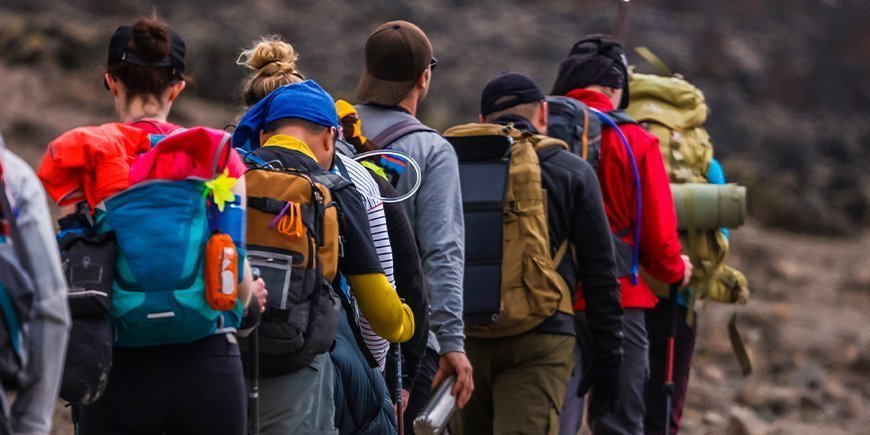
A lot of questions can pop into your head when packing for the adventure of a lifetime.
We’ve tried to answer some of the questions we’re most frequently asked by our guests here
Who will carry my gear?
When you climb Kilimanjaro, there are porters (or a porter) who will transport your personal luggage to the next camp en route on the climb itself.
The bag should be packed in such a way that the porter can carry it on his head – in a rucksack, a soft bag or similar, for example. You will not have access to this luggage during the day.
The bag should weigh no more than 15 kg. If it weighs more than this, you’ll be charged 10 US dollars extra per bag per day.
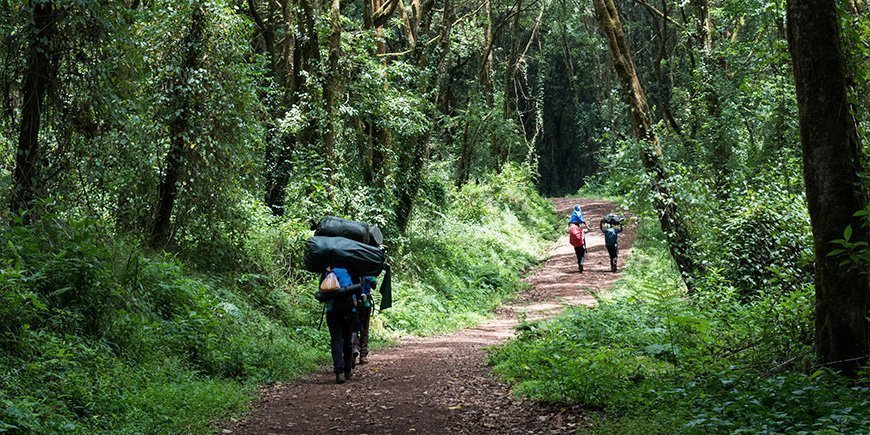
How much will I have to carry myself?
You’ll have to carry your own day rucksack, which should contain everything you’ll need during the day during the actual ascent, i.e. everything you’ll need until you reach camp in the evening.
What should be packed in the day rucksack varies from person to person, but we recommend that you bring a bottle of water, snacks, a small first aid kit, sunscreen, a camera, rainwear, gloves, a woolly hat, a sun hat and some extra warm clothes as a minimum.
How big a rucksack should I bring?
We recommend a rucksack with around a 30-litre capacity, a hip belt and rain cover. It’s important to choose a light, durable rucksack.
Remember to pack your belongings in waterproof bags (i.e. dry bags) to protect them from dust and rain. Please note that all use, import and production of disposable plastic bags is prohibited in Tanzania.
What sleeping bag should I have with me?
When you climb Kilimanjaro, you pass through several climate zones, and it gets cold at night, especially when you come higher up the mountain. So you should choose a sleeping bag that takes this into account.
When shopping for a sleeping bag, look at the comfort temperature. The comfort temperature is the lowest temperature at which the user can lie in a relaxed posture in the sleeping bag and still feel comfortable. And this varies according to your size, gender and how cold-hardy you are.
We recommend that you choose a sleeping bag with a comfort temperature down to at least -10 degrees and preferably more if you get cold easily.
Make sure the sleeping bag is light and compressible so that it takes up as little space as possible for easy transportation.
If you don’t own or want to buy a sleeping bag yourself, you can rent one at the hotel. In addition to your own or rented sleeping bag, you might like to bring an inner sheet for extra warmth.
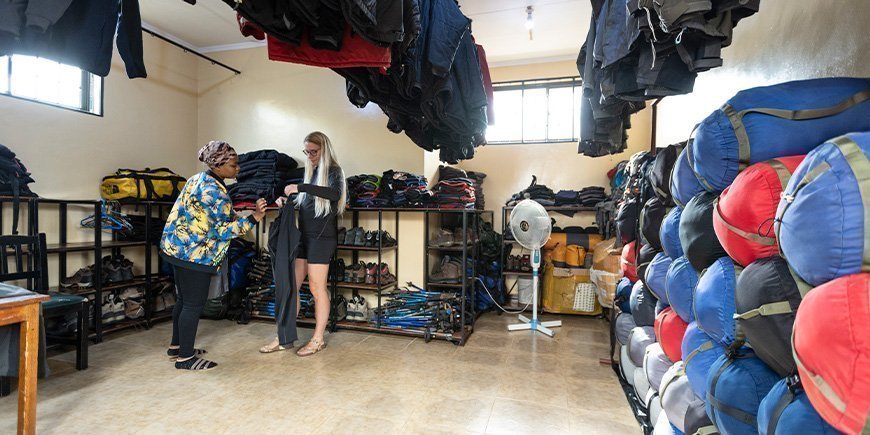
Do I need to bring a sleeping mat?
On the Machame, Shira, Rongai and Lemosho routes, there are foam mattresses in the tents.
You might like to bring your own sleeping mat for extra comfort – preferably one that insulates against cold temperatures. If you choose a self-inflating sleeping mat, we recommend that it is between 5 and 7 centimetres high, so that you lie comfortably.
An insulating sleeping mat is essential to prevent cold from the ground from getting through and ensure that you stay warm at night. Choose a lightweight sleeping mat that folds away easily for added convenience.
What should I wear?
When choosing what clothes to bring with you to Kilimanjaro, it’s important to think in layers.
The temperature can vary, and it may both rain and snow, so bring light, moisture-wicking materials that dry quickly. Avoid cotton as it retains moisture.
Bring both long trousers and shorts, and be sure to bring a lightweight gilet or jacket with multiple pockets to store essentials such as sunscreen, insect repellent and a camera.
What walking boots should I choose?
When choosing hiking boots for the trek, there are some important things to consider.
Make sure you bring hiking boots that are neither too light nor too heavy. Comfort is everything as you’ll be hiking in several different types of terrain. The boots must be able to resist water, they should support your ankles and they must be able to keep your feet warm during the hike. It’s also important to break in your hiking boots before the climb.
You might also like to bring a pair of comfortable shoes or sandals for relaxing in the evening.
In addition to a good pair of shoes, good hiking socks are also essential to avoid blisters and to increase comfort.
Packing list including PDF
Download our recommended packing list for climbing Kilimanjaro as a PDF.
Below is our recommended (gross) packing list for your Kilimanjaro climb. Please note that this list only applies to the climb itself and not the tour to Zanzibar or safari in Tanzania if that is part of your tour.
Before you start packing, we recommend that you check the weather forecast for Kilimanjaro and adjust your packing accordingly.
Be sure to have the most essential items in your hand luggage. If the worst happens and your luggage is delayed, it is important to have the things you can’t do without on hand. Also, be aware of items that MUST be in your hand luggage, including some electronics. Check the specific rules with your airline.
Clothes & shoes:
- Underwear
- Hiking socks/moisture-wicking socks
- Long-sleeved and long-legged underwear*
- Trousers
- T-shirts/short-sleeved shirts
- Long-sleeved shirts or blouses for walking and relaxing in the evening
- Fleece sweater or Icelandic sweater*
- Fleece trousers*
- Long jacket or ski jacket*
- Rainwear (both trousers and jacket) for the rainforest and cold snow*
- Gloves/mittens (waterproof)*
- Sunhat/cap to protect you from the sun
- Warm hat that covers as much of the head, cheeks and neck as possible – preferably a balaclava*
- Hand and foot warmers (chemically activated)
- Hiking boots*
- Trainers or sandals for relaxing in the evening
- Leg warmers for the lower leg. We recommend that they can be fastened to the hiking boots
- Sunglasses
Food and drink:
- Reusable water bottle such as a CamelBak. These will be filled with clean, boiled water every morning. If you wish to further purify the drinking water, you can bring your own water filter or purification tablets
- Energy bars and drinks, snacks, chocolate and the like
Other equipment:
- Day rucksack*
- Hiking poles*
- Sleeping bag*
- Sleeping mat
- Head lamp or torch
- Batteries. Remember to bring at least one extra set for anything that uses batteries, as the cold weather shortens battery life
- Adaptor
- Powerbank
Toiletries:
- Toothbrush and toothpaste
- Contact lenses/glasses
- Toilet paper and bag for used toilet paper (e.g. drybag or zip bag) – you must take all your waste with you
- Quick-drying towel + soap
- Sun cream
- Lip balm with SPF
- Hand sanitiser
- First-aid kit (including blister plasters)
- Prescription medicines
- Insect repellent
- Sleeping mask/earplugs
- Diamox to prevent altitude sickness. Consult your GP
Miscellaneous:
- Passport
- Visa
- Vaccination card
- Credit card
- Money
- Insurance documents
- Travel documents
*Available to rent (used) at Springlands Hotel. See prices on our Practical information page.
Please note that all use, import and production of plastic bags, such as those we know from supermarkets (i.e. disposable plastic bags) is prohibited in Tanzania. We therefore recommend that you avoid using plastic bags when packing your luggage. Use fabric bags instead, or bags made of a waterproof material other than plastic.
Get prepared for an exciting tour and take the first step towards Kilimanjaro’s majestic peak!
